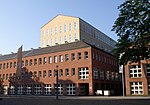Staatliche Kunsthalle Karlsruhe

The Staatliche Kunsthalle (State Art Gallery) is an art museum in Karlsruhe, Germany. The museum, created by architect Heinrich Hübsch, opened in 1846 after nine years of work in a neoclassical building next to the Karlsruhe Castle and the Karlsruhe Botanical Garden. This historical building with its subsequent extensions now houses the part of the collection covering the 14th to the 19th century while the 20th century is displayed in the nearby building of the Botanical Gardens's former orangery. The museum notably displays paintings by the Master of the Karlsruhe Passion, Matthias Grünewald (most notably the Tauberbischofsheim Altarpiece), Albrecht Dürer, Hans Baldung, Lucas Cranach the Elder, Hans Burgkmair, Rembrandt, Pieter de Hooch, Peter Paul Rubens, David Teniers the Younger, Hyacinthe Rigaud, Claude Lorrain, Nicolas Poussin, Jean-Baptiste-Siméon Chardin, Eugène Delacroix, Gustave Courbet, Édouard Manet, Camille Pissarro, Claude Monet, Edgar Degas, Auguste Renoir, Paul Cézanne, Paul Gauguin, Caspar David Friedrich, Hans Thoma, Lovis Corinth, August Macke, Ernst Ludwig Kirchner, Erich Heckel, Franz Marc, Jean-Marc Nattier, Max Pechstein, Max Ernst, Kurt Schwitters, Juan Gris, Yves Tanguy, Robert Delaunay, Otto Dix and Fritz von Uhde.
Excerpt from the Wikipedia article Staatliche Kunsthalle Karlsruhe (License: CC BY-SA 3.0, Authors, Images).Staatliche Kunsthalle Karlsruhe
Hans-Thoma-Straße, Karlsruhe Innenstadt-West
Geographical coordinates (GPS) Address Nearby Places Show on map
Geographical coordinates (GPS)
| Latitude | Longitude |
|---|---|
| N 49.011888888889 ° | E 8.4 ° |
Address
Staatliche Kunsthalle Karlsruhe
Hans-Thoma-Straße 2
76133 Karlsruhe, Innenstadt-West
Baden-Württemberg, Germany
Open on Google Maps











